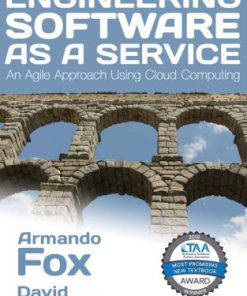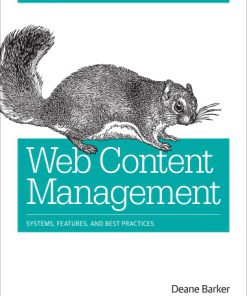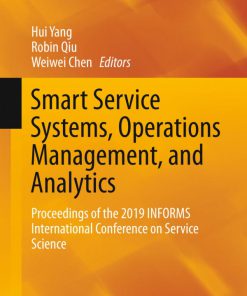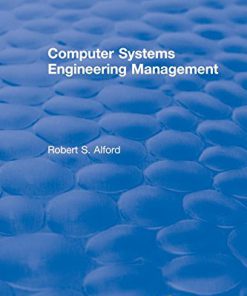Service Systems Engineering and Management 1st Edition by Ravi Ravindran, Paul Griffin, Vittaldas Prabhu 1498723084 9781498723084
$50.00 Original price was: $50.00.$25.00Current price is: $25.00.
Service Systems Engineering and Management 1st Edition by A. Ravi Ravindran, Paul M. Griffin, Vittaldas V. Prabhu – Ebook PDF Instant Download/DeliveryISBN: 1498723084, 9781498723084
Full download Service Systems Engineering and Management 1st Edition after payment.

Product details:
ISBN-10 : 1498723084
ISBN-13 : 9781498723084
Author: A. Ravi Ravindran, Paul M. Griffin, Vittaldas V. Prabhu
Recipient of the 2019 IISE Institute of Industrial and Systems Engineers Joint Publishers Book-of-the-Year Award This is a comprehensive textbook on service systems engineering and management. It emphasizes the use of engineering principles to the design and operation of service enterprises. Service systems engineering relies on mathematical models and methods to solve problems in the service industries. This textbook covers state-of-the-art concepts, models and solution methods important in the design, control, operations and management of service enterprises. Service Systems Engineering and Management begins with a basic overview of service industries and their importance in today’s economy. Special challenges in managing services, namely, perishability, intangibility, proximity and simultaneity are discussed. Quality of service metrics and methods for measuring them are then discussed. Evaluating the design and operation of service systems frequently involves the conflicting criteria of cost and customer service. This textbook presents two approaches to evaluate the performance of service systems – Multiple Criteria Decision Making and Data Envelopment Analysis. The textbook then discusses several topics in service systems engineering and management – supply chain optimization, warehousing and distribution, modern portfolio theory, revenue management, retail engineering, health systems engineering and financial services. Features: Stresses quantitative models and methods in service systems engineering and management Includes chapters on design and evaluation of service systems, supply chain engineering, warehousing and distribution, financial engineering, healthcare systems, retail engineering and revenue management Bridges theory and practice Contains end-of-chapter problems, case studies, illustrative examples, and real-world applications Service Systems Engineering and Management is primarily addressed to those who are interested in learning how to apply operations research models and methods for managing service enterprises. This textbook is well suited for industrial engineering students interested in service systems applications and MBA students in elective courses in operations management, logistics and supply chain management that emphasize quantitative analysis.
Service Systems Engineering and Management 1st Table of contents:
Chapter 1 Service Systems: An Overview
1.1 Goods and Services
1.2 Differences between Goods and Services
1.2.1 Intangibility
1.2.2 Perishability
1.2.3 Proximity
1.2.4 Simultaneity
1.3 Challenges Posed by Services
1.3.1 Impact of Technology
1.3.2 Bundled Products
1.3.3 Self-Service
1.3.4 Service Quality
1.3.5 Managing Capacity and Demand
1.4 Classification of Services
1.4.1 Service Industries
1.4.1.1 Communications
1.4.1.2 Education
1.4.1.3 Entertainment
1.4.1.4 Financial Services
1.4.1.5 Government Services
1.4.1.6 Healthcare
1.4.1.7 Hospitality and Leisure
1.4.1.8 Insurance
1.4.1.9 Professional Services
1.4.1.10 Retail and Wholesale
1.4.1.11 Transportation
1.4.1.12 Utilities
1.4.2 Ancillary and Support Services
1.4.3 Service Process Matrix
1.4.3.1 Service Factory
1.4.3.2 Service Shop
1.4.3.3 Mass Service
1.4.3.4 Professional Service
1.4.3.5 Use of Service Process Matrix
1.5 Role of Services in the Economy
1.5.1 U.S. Employment by Sector
1.5.2 U.S. GDP by Sector
1.6 Strength of American Manufacturing
1.6.1 Decline in U.S. Manufacturing
1.6.2 Revival of U.S. Manufacturing
1.7 What Is Service Systems Engineering?
1.7.1 Engineering Issues in Service Systems
1.7.2 Engineering Problems in Services
1.7.3 Multiple-Criteria Decision Making in Services
1.8 Quality of Service
1.8.1 QoS Measures
1.8.2 Dimensions of Service Quality
1.9 Methods for Measuring Service Quality
1.9.1 SERVQUAL
1.9.2 Statistical Process Control
1.9.2.1 Variable Control Charts
1.9.2.2 Attribute Control Charts
1.9.2.3 Selecting the Sample Size for Control Charts
1.9.2.3.1 Attribute Control Charts
1.9.2.3.2 Variable Control Charts
1.9.3 Other Service Quality Tools
1.9.3.1 Run Chart
1.9.3.2 Histogram
1.9.3.3 Pareto Chart
1.9.3.4 Scatterplot
1.9.3.5 Flowchart
1.9.3.6 Fishbone Diagram
1.10 Summary
Exercises
References
Chapter 2 Forecasting Demand for Services
2.1 Role of Demand Forecasting in Services
2.2 Forecasting Process
2.3 Qualitative Forecasting Methods
2.3.1 Executive Committee Consensus
2.3.2 Delphi Method
2.3.3 Survey of Sales Force
2.3.4 Customer Surveys
2.4 Quantitative Forecasting Methods
2.4.1 Time Series Forecasting
2.4.2 Constant Level Forecasting Methods
2.4.3 Last Value Method
2.4.4 Averaging Method
2.4.5 Simple Moving Average Method
2.4.6 Weighted Moving Average Method
2.4.7 Computing Optimal Weights by Linear Programming Model
2.4.8 Exponential Smoothing Method
2.4.8.1 Choice of Smoothing Constant (α)
2.5 Incorporating Seasonality in Forecasting
2.6 Incorporating Trend in Forecasting
2.6.1 Simple Linear Trend Model
2.6.2 Holt’s Method
2.7 Incorporating Seasonality and Trend in Forecasting
2.7.1 Method Using Static Seasonality Indices
2.7.2 Winters Method
2.8 Forecasting for Multiple Periods
2.8.1 Multi-Period Forecasting Problem
2.8.2 Multi-Period Forecasting under Constant Level
2.8.3 Multi-Period Forecasting with Seasonality
2.8.4 Multi-Period Forecasting with Trend
2.8.5 Multi-Period Forecasting with Seasonality and Trend
2.9 Forecasting Errors
2.9.1 Uses of Forecast Errors
2.9.2 Selecting the Best Forecasting Method
2.10 Monitoring Forecast Accuracy
2.10.1 Tracking Signal
2.11 Forecasting Software
2.11.1 Types of Forecasting Software
2.11.1.1 Automatic Software
2.11.1.2 Semi-Automatic Software
2.11.1.3 Manual Software
2.11.2 User Experience with Forecasting Software
2.12 Forecasting in Practice
2.12.1 Real-World Applications
2.12.2 Forecasting in Practice: Survey Results
2.13 Summary and Further Readings
2.13.1 Demand Forecasting—Summary
2.13.2 ARIMA Method
2.13.3 Croston’s Method
2.13.4 Further Readings in Forecasting
Exercises
References
Chapter 3 Design of Service Systems
3.1 Modeling with Binary Variables
3.1.1 Capital Budgeting Problem
3.1.2 Fixed Charge Problem
3.1.3 Constraint with Multiple Right-Hand-Side (RHS) Constants
3.1.4 Quantity Discounts
3.1.4.1 “All-Unit” Quantity Discounts
3.1.4.2 Graduated Quantity Discount
3.1.5 Handling Nonlinear Integer Programs
3.2 Set Covering and Set Partitioning Models
3.2.1 Set Covering Problem
3.2.2 Set Partitioning Problem
3.2.3 Application to Warehouse Location
3.2.4 Application to Airline Scheduling
3.2.4.1 Airline Scheduling
3.2.4.2 Use of Set Covering and Partitioning Model
3.2.4.3 Crew Scheduling Model
3.2.4.4 Airline Applications
3.2.5 Workforce Planning
3.2.5.1 Workforce Planning Applications
3.2.6 Real-World Applications
3.2.6.1 Ford Motor Company
3.2.6.2 United Parcel Service
3.2.6.3 Wishard Memorial Hospital
3.2.6.4 Mount Sinai Hospital
3.2.6.5 United Airlines
3.3 Queuing Models in Service Systems
3.3.1 Introduction
3.3.2 Poisson Processes
3.3.3 The M/M/1 Model
3.3.4 The M/M/c Model
3.3.5 The M/M/c/K Model
3.3.6 The G/G/c Model
3.3.7 Queuing Networks
3.3.8 Modeling a Call Center as a Queuing System
3.3.8.1 Time-Varying Arrivals
3.3.8.2 Service Times
3.3.8.3 Customer Abandonment
3.3.8.4 Staffing
3.3.8.5 Discussion
Exercises
Steps of ISA
References
Chapter 4 Evaluation of Service Systems
4.1 Multiple-Criteria Decision Making—An Overview
4.2 Multiple-Criteria Selection Problems
4.2.1 Concept of “Best Solution”
4.2.2 Dominated Alternative
4.2.3 Non-Dominated Alternatives
4.2.4 Ideal Solution
4.3 Multiple-Criteria Ranking Methods
4.3.1 Rating Method
4.3.2 Borda Method
4.3.3 Pairwise Comparison of Criteria
4.3.4 Scaling Criteria Values
4.3.5 Analytic Hierarchy Process
4.4 MCMP Problems
4.4.1 MCMP Problem
4.4.2 Efficient, Non-Dominated, or Pareto Optimal Solution
4.4.3 Determining an Efficient Solution
4.4.4 Test for Efficiency
4.5 Classification of MCMP Methods
4.6 Goal Programming
4.6.1 Goal Programming Formulation
4.6.2 Solution of Goal Programming Problems
4.6.2.1 Linear Goal Programs
4.6.2.2 Integer Goal Programs
4.6.2.3 Nonlinear Goal Programs
4.7 Method of Global Criterion and Compromise Programming
4.7.1 Compromise Programming
4.8 Interactive Methods
4.9 MCDM Applications
4.10 MCDM Software
4.11 Data Envelopment Analysis
4.11.1 Production Function
4.11.2 Technology
4.11.3 Nonparametric Models
4.12 DEA Linear Programming Formulation
4.13 Practical Considerations for DEA
4.14 Allocative and Total Efficiency in DEA
4.15 Stochastic DEA
4.16 DEA Software
Exercises
References
Chapter 5 Supply Chain Engineering
5.1 Supply Chain Decisions and Design Metrics
5.1.1 Flows in Supply Chains
5.1.2 Meaning of SCE
5.1.3 Supply Chain Decisions
5.1.4 Enablers and Drivers of Supply Chain Performance
5.1.4.1 Supply Chain Enablers
5.1.4.2 Supply Chain Drivers
5.1.5 Assessing and Managing Supply Chain Performance
5.1.5.1 Supply Chain Efficiency
5.1.5.2 Supply Chain Responsiveness
5.1.5.3 Supply Chain Risk
5.1.5.4 Conflicting Criteria in Supply Chain Optimization
5.1.6 Relationship between Supply Chain Metrics and Financial Metrics
5.1.6.1 Supply Chain Metrics
5.1.6.2 Business Financial Metrics
5.1.7 Importance of SCM
5.1.7.1 Supply Chain Top 25
5.2 Supply Chain Network Design and Distribution
5.2.1 Supply Chain Distribution Planning
5.2.2 Location–Distribution Problem
5.2.3 Location–Distribution with Dedicated Warehouses
5.2.4 Supply Chain Network Design
5.2.5 Real-World Applications
5.2.5.1 Multinational Consumer Products Company
5.2.5.1.1 Case 1: Supply Chain Network Design
5.2.5.1.2 Case 2: Supply Chain Distribution Planning
5.2.5.2 Procter and Gamble
5.2.5.3 Hewlett–Packard
5.2.5.4 BMW
5.2.5.5 AT&T
5.3 Outsourcing Decisions and Supplier Selection
5.3.1 Importance of Supplier Selection
5.3.2 Supplier Selection Process
5.3.3 In-House or Outsource
5.3.4 Supplier Selection Methods
5.3.4.1 Sourcing Strategy
5.3.4.2 Criteria for Selection
5.3.4.3 Prequalification of Suppliers
5.3.4.4 Final Selection
5.3.5 Single Sourcing Methods for Supplier Selection
5.3.6 Multi-Criteria Ranking Methods for Supplier Selection
5.3.6.1 Case Study 1: Ranking of Suppliers
5.3.6.2 Use of the Lp Metric for Ranking Suppliers
5.3.6.2.1 Steps of the L2 metric method
5.3.6.3 Rating (Scoring) Method
5.3.6.4 Borda Method
5.3.6.4.1 Pairwise Comparison of Criteria
5.3.6.5 Analytic Hierarchy Process
5.3.6.5.1 Basic Principles of AHP
5.3.6.5.2 Steps of the AHP Model
5.3.7 Scaling Criteria Values
5.3.7.1 Simple Scaling
5.3.7.2 Ideal Value Method
5.3.7.3 Simple Linearization (Linear Normalization)
5.3.7.4 Use of L p Norm (Vector Scaling)
5.3.7.5 Illustrative Example of Scaling Criteria Values
5.3.7.6 Simple Scaling Illustration
5.3.7.7 Illustration of Scaling by Ideal Value
5.3.7.8 Simple Linearization (Linear Normalization) Illustration
5.3.7.9 Illustration of Scaling by Lp Norm
5.3.8 Group Decision Making
5.3.9 Comparison of Ranking Methods
5.3.10 Multiple Sourcing Methods for Supplier Selection and Order Allocation
5.3.10.1 Case Study 2
5.3.10.2 Solution of Case Study 2
5.4 Supply Chain Logistics
5.4.1 Mode Selection
5.4.2 Vehicle Routing
5.4.3 Inventory Modeling
5.5 Supply Chain Pooling and Contracting
5.5.1 An Introduction to Pooling
5.5.1.1 Location Pooling
5.5.1.2 Postponement
5.5.1.3 Product Pooling
5.5.1.4 Correlation and Pooling
5.5.2 Supply Chain Contracting
Exercises
References
Chapter 6 Warehousing and Distribution
6.1 Warehouse Functions
6.2 Warehouse Equipment
6.2.1 Moving Product
6.2.2 Storing Product
6.2.3 Sorting Product
6.2.4 Tracking Product
6.3 Warehouse Design
6.3.1 Material Flow and Staffing
6.3.2 Storage Strategies
6.3.3 Warehouse Layout
6.3.4 Aisle Layout
6.4 Order Picking
6.5 Slotting
6.5.1 SKU Profiling
6.5.2 Prioritizing SKUs
6.5.3 Packing SKUs
6.6 Forward–Reserve
6.7 Line Balancing and Bucket Brigades
6.8 Cross Docking
6.9 Warehouse Location and Inventory
6.10 Further Readings
Exercises
References
Chapter 7 Financial Engineering
7.1 Basic Concepts in Investing
7.1.1 Investing in Cash
7.1.2 Investing in Bonds
7.1.3 Investing in Stocks
7.1.4 Asset Allocation
7.1.5 Mutual Funds
7.2 A Simple Model for Portfolio Selection
7.2.1 Linear Programming Model
7.2.2 Drawbacks of the LP Model
7.3 Markowitz’s Mean Variance Model for Portfolio Selection
7.3.1 Quantifying Investment Risk
7.3.2 Excel Functions to Compute Investment Risk
7.3.3 Markowitz’s Bi-Criteria Model
7.3.4 Risk–Return Graph for Portfolio Selection
7.3.5 Use of Portfolio Mean and Standard Deviation
7.3.6 Illustration of Markowitz’ Model
7.4 Sharpe’s Bi-Criteria Model for Portfolio Selection
7.4.1 Market Risk of a Security
7.4.2 Meaning of the S&P 500 Index
7.4.3 Calculating Beta Risk
7.4.4 Sharpe’s Bi-Criteria Model
7.4.5 Illustration of Sharpe’s Model
7.5 Investing in Bonds
7.5.1 Understanding Bonds
7.5.2 Price, Yield, and Coupons
7.5.3 Types of Bonds
7.5.4 Bond Ratings
7.5.5 Bond Duration
7.5.6 Bond Convexity
7.5.7 Immunization
7.5.8 Selecting a Bond Portfolio
7.6 Principles of Investing
7.6.1 Annualized Returns
7.6.2 Dollar Cost Averaging Principle
7.6.3 Investing in Mutual Funds
7.6.3.1 Load versus No-Load Funds
7.6.3.2 Stock Mutual Funds
7.6.3.3 Bond Mutual Funds
7.6.3.4 Balanced Mutual Funds
7.6.3.5 Index Funds
7.6.3.6 Life Cycle or Target Date Funds
7.6.4 Investment Strategies
Exercises
References
Chapter 8 Revenue Management
8.1 History of Revenue Management
8.2 Difficulties in Managing Service Capacity
8.3 Revenue Management Strategies in Services
8.3.1 Proactive Strategies to Manage Customer Demand
8.3.1.1 Use of Reservations/Appointment Systems
8.3.1.2 Customer Segmentation
8.3.1.3 Differential Pricing
8.3.1.4 Sales Promotions
8.3.2 Reactive Strategies for Capacity Planning
8.3.2.1 Workforce Planning
8.3.2.2 Use of Part-Time/Temporary Workers
8.3.2.3 Cross-Training of Employees
8.3.2.4 Promoting Self-Service
8.3.2.5 Designing Adjustable Capacity
8.3.3 Applicability of Revenue Management
8.4 Optimization Models for Overbooking
8.4.1 No-Show Problem
8.4.2 Practice of Overbooking
8.4.3 Optimization Problem
8.4.3.1 Input Data
8.4.3.2 Objective Function
8.4.3.3 Overbooking Policy for the Continuous Case
8.4.3.4 Overbooking Policy for the Discrete Case
8.4.3.5 Illustrative Example
8.5 Revenue Management in Airlines
8.5.1 Airline Fare Classes
8.5.2 Setting Limits on Two Fare Classes
8.5.2.1 Optimization Problem
8.5.3 Setting Limits on Multiple Fare Classes
8.5.4 Bid Price Controls
8.5.5 Booking Curves
8.5.6 Remarks on Airline Revenue Management
Exercises
References
Chapter 9 Retail Engineering
9.1 Introduction
9.2 Types of Retailers
9.3 Financial Strategy in Retailing
9.3.1 Financial Reporting
9.3.2 Assets, Liabilities, and Stockholder’s Equity
9.3.3 Balance Sheet
9.3.4 Income Statement
9.3.5 Cash Flow Statement
9.4 Financial Metrics in Retailing
9.5 Analysis of Balance Sheet
9.6 DuPont Model
9.7 Breakeven Analysis
9.8 Checkout Process Staffing
Exercises
References
Chapter 10 Healthcare Delivery Systems
10.1 Introduction
10.1.1 U.S. Healthcare Costs
10.1.2 Healthcare Outcomes
10.2 Healthcare Financing
10.2.1 Health Insurance
10.2.2 Provider Compensation
10.2.3 Provider Cost Allocation
10.3 Healthcare Components
10.3.1 Hospital Units
10.3.2 Patient Services
10.3.3 Patient Flow
10.3.4 Value Stream Mapping
10.4 Health Information Technology
10.4.1 Medical Coding
10.4.2 Electronic Health Record
10.4.3 Health Information Exchange
10.4.4 Claims and Billing
10.5 Resource Management
10.5.1 Nurse Scheduling
10.5.2 OR Scheduling
10.5.3 Capacity Management for Imaging Equipment
10.5.4 Bed Management
10.6 Health Analytics
10.6.1 Randomized Controlled Trials
10.6.2 Measuring Accuracy
10.6.3 Prediction by Support Vector Machines
10.6.4 Prediction Example: 30-Day Readmissions
10.7 Discussion
Exercises
References
Chapter 11 Financial Services
11.1 Payment Systems
11.2 Banking
11.2.1 Staffing and Customer Waiting Time
11.2.2 Diversifying Banking Channels
11.3 Electronic Trading
11.4 Valuing Companies and Their Stock Prices
11.4.1 Company Valuation Using Discounted Cash Flows
11.4.2 Price–Earnings Ratio
11.4.3 PE Growth Ratio
11.4.4 Earnings Estimates
11.4.5 Technical Analysis
11.4.6 Cup with Handle
11.4.7 Head and Shoulders Pattern
11.5 Derivatives
11.6 Options
11.6.1 Call Option
11.6.2 Put Option
11.6.3 Option Valuation
11.6.3.1 Binomial Option Pricing
11.6.3.2 Black–Scholes Option Valuation
People also search for Service Systems Engineering and Management 1st:
engine management system meaning
what is a systems engineering management plan
engine servicing procedure
service systems engineering
systems and engineering management
Tags: Service Systems, Engineering, Management, Ravi Ravindran, Paul Griffin, Vittaldas Prabhu
You may also like…
Computers - Web Development
Web content management systems features and best practices First Edition Barker
Business & Economics - Industries
Engineering
Business & Economics - Management & Leadership
An Elegant Puzzle Systems of Engineering Management Will Larson
Business & Economics
Business & Economics - Management & Leadership












